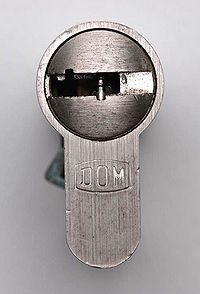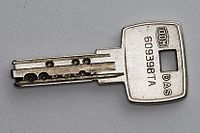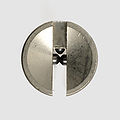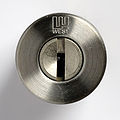Dimple: Difference between revisions
(Created page with '=Dimple= A '''dimple''' lock is a pin-tumbler-based lock design that uses flat side of the key blade as a bitting area. Cuts on the bitting area resemble dimples, hence …') |
m (corrected links to Pin_tumbler, Mul_T_Lock, KABA) |
||
| (12 intermediate revisions by 3 users not shown) | |||
| Line 1: | Line 1: | ||
= | <span style="font-size: 188%;">{{PAGENAME}}</span> | ||
---- | |||
[[File:DOM_DAS_cylinder.jpg|thumb|right|text-top|200px|A [[DOM]] dimple lock.]] | |||
Most dimple | A '''dimple''' lock is a [[Pin_tumbler |pin-tumbler]] [[lock]] design that uses the flat side of the key blade as a bitting area. Cuts on the bitting area resemble dimples, hence the name. This contrasts traditional pin-tumblers that use the edge of the blade as the primary bitting area. Most dimple locks orient the keyway of the lock perpendicular to the pin stacks and allow the [[key]] to be inserted in any orientation. | ||
Dimple locks are used in a wide variety of applications, and may vary from low to high security. A dimple lock is not more secure when compared to traditional pin tumbler locks, but the untraditional nature of the key makes many dimple locks appear sophisticated. Some of the most notable dimple lock manufacturers are [[KABA]], [[Mul_T_Lock |Mul-T-Lock]], [[DOM]], [[LIPS]], [[Goal |GOAL]], and [[KESO]]. | |||
__TOC__ | __TOC__ | ||
<br clear=all> | |||
== History == | == History == | ||
| Line 14: | Line 16: | ||
== Principles of operation == | == Principles of operation == | ||
:''See [[ | [[File:DOM_DAS_key.jpg|thumb|right|text-top|200px|A [[DOM]] dimple key.]] | ||
:''See [[Pin_tumbler#Principles of operation|Pin-tumbler (Principles of operation)]] | |||
Traditional dimple locks are functionally equivalent to pin-tumblers; the [[plug]] may rotate when dimples in the key properly position a number of pin-tumbler stacks at the [[shear line]]. The only difference is the orientation of the keyway and the location and style of the bitting cuts on the key blade. More advanced dimple locks use various high-security features like key profiling, [[side pin]]s, [[telescoping pin]]s, and [[axial rotation]]. Additional passive and active locking mechanisms are also common, such as [[sidebar]]s and moving elements within the key itself. | |||
The relationship between the keyway and the pins in a dimple lock limits the number of available depths for each pin (a function of the key thickness, pin design, and manufacturing tolerances). Where traditional pin-tumblers allow anywhere from six to twelve positions per pin, dimple locks generally allow two to six depths per pin. Regardless, modern dimple locks allow for pins positioned on all sides of the key, greatly increasing the number of pin positions available. This provides increasing key control and master keying capabilities when compared to traditional pin-tumblers. Traditional pin-tumblers have problems with increasing the number of pins because the key must be extended to accomodate the extra pins. Past a certain point (generally seven or eight pins) traditional pin-tumbler keys become too long and have problems with bending and breaking. | |||
<br clear=all> | |||
== Vulnerabilities == | == Vulnerabilities == | ||
| Line 21: | Line 31: | ||
* [[Lockpicking]] | * [[Lockpicking]] | ||
* [[Pick Gun]]s | * [[Pick Gun]]s* | ||
* [[Key bumping]] | * [[Key bumping]] | ||
* [[Tryout Keys]] | * [[Tryout Keys]] | ||
| Line 28: | Line 38: | ||
* [[Decoding]] | * [[Decoding]] | ||
* [[Bypass]] | * [[Bypass]] | ||
'''Note''' | |||
* Pick guns have limited effectiveness against dimple locks because of the poor range of motion allowed in the dimple keyway. | |||
== Gallery == | |||
<gallery align="center"> | |||
File:Dimple-West 917 key + dimple cuts hor - FXE47909.jpg | Dimple cuts in a [[WEST 917]] key | |||
File:Dimple-Kaba experT key - FXE47916.jpg | Dimple cuts in a [[KABA|Kaba experT]] key with dimple cuts | |||
File:Dimple-Goal D9 key - FXE47012.jpg | Dimple cuts in a [[Goal D9 |GOAL D9]] key | |||
File:Dimple-West 917 pins in core - FXE47899-Edit.jpg | Pins for a dimple key in core of the [[WEST 917]] | |||
File:Dimple-West 917 cylinder front - closer - FXE47516.jpg | Vertical dimple keyway of the [[WEST 917]] | |||
File:Dimple-MTL Jr keyway lighter - FXE44819.jpg | Horizontal dimple keyway of the [[Mul_T_Lock |Mul-T-Lock]] Jr. | |||
</gallery> | |||
== References == | == References == | ||
| Line 33: | Line 56: | ||
== See also == | == See also == | ||
* [[Pin-tumbler]] | * [[Pin_tumbler |Pin-tumbler]] | ||
* [[Lock]] | * [[Lock]] | ||
* [[Key]] | * [[Key]] | ||
| Line 39: | Line 62: | ||
[[Category:Locks]] | [[Category:Locks]] | ||
[[Category:Dimple locks| ]] | [[Category:Dimple locks| ]] | ||
[[Category:Horizontal keyways| ]] | |||
{{Stub}} | {{Stub}} | ||
Latest revision as of 02:16, 28 January 2023
Dimple

A dimple lock is a pin-tumbler lock design that uses the flat side of the key blade as a bitting area. Cuts on the bitting area resemble dimples, hence the name. This contrasts traditional pin-tumblers that use the edge of the blade as the primary bitting area. Most dimple locks orient the keyway of the lock perpendicular to the pin stacks and allow the key to be inserted in any orientation.
Dimple locks are used in a wide variety of applications, and may vary from low to high security. A dimple lock is not more secure when compared to traditional pin tumbler locks, but the untraditional nature of the key makes many dimple locks appear sophisticated. Some of the most notable dimple lock manufacturers are KABA, Mul-T-Lock, DOM, LIPS, GOAL, and KESO.
History
Add to me!
Principles of operation

Traditional dimple locks are functionally equivalent to pin-tumblers; the plug may rotate when dimples in the key properly position a number of pin-tumbler stacks at the shear line. The only difference is the orientation of the keyway and the location and style of the bitting cuts on the key blade. More advanced dimple locks use various high-security features like key profiling, side pins, telescoping pins, and axial rotation. Additional passive and active locking mechanisms are also common, such as sidebars and moving elements within the key itself.
The relationship between the keyway and the pins in a dimple lock limits the number of available depths for each pin (a function of the key thickness, pin design, and manufacturing tolerances). Where traditional pin-tumblers allow anywhere from six to twelve positions per pin, dimple locks generally allow two to six depths per pin. Regardless, modern dimple locks allow for pins positioned on all sides of the key, greatly increasing the number of pin positions available. This provides increasing key control and master keying capabilities when compared to traditional pin-tumblers. Traditional pin-tumblers have problems with increasing the number of pins because the key must be extended to accomodate the extra pins. Past a certain point (generally seven or eight pins) traditional pin-tumbler keys become too long and have problems with bending and breaking.
Vulnerabilities
Dimple locks are vulnerable to all of the same attacks as traditional pin-tumbler locks:
Note
- Pick guns have limited effectiveness against dimple locks because of the poor range of motion allowed in the dimple keyway.
Gallery
Dimple cuts in a WEST 917 key
Dimple cuts in a Kaba experT key with dimple cuts
Dimple cuts in a GOAL D9 key
Pins for a dimple key in core of the WEST 917
Vertical dimple keyway of the WEST 917
Horizontal dimple keyway of the Mul-T-Lock Jr.
References
See also
| This article is a stub. You can help Lockwiki by expanding it. |






